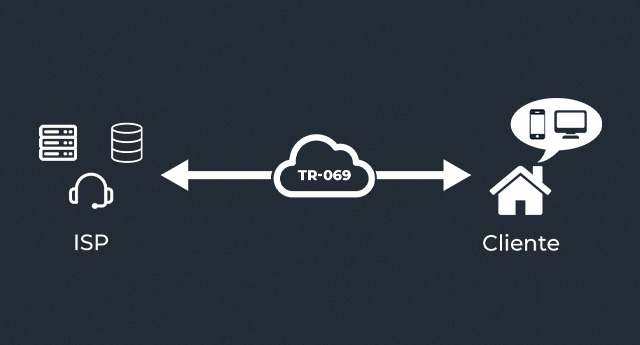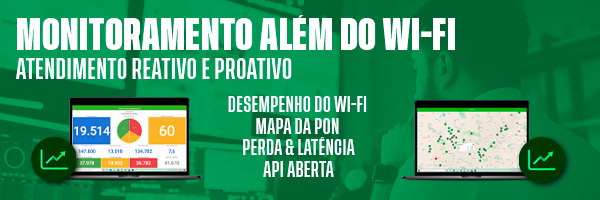No cenário atual da tecnologia, onde a conectividade e a eficiência são fundamentais, o gerenciamento de dispositivos de rede na casa do cliente, como roteadores e ONTs, torna-se uma tarefa crucial para provedores de internet. Seja para garantir a segurança ou simplificar a resolução de problemas, a forma como você gerencia o seu roteador na casa do cliente pode fazer uma grande diferença. E é aí que o protocolo TR-069 ganha destaque, principalmente em cima da interface web do equipamento.
Vamos analisar as diferenças entre o gerenciamento do roteador via interface web e o TR-069 e apresentar três vantagens incontestáveis do TR-069 que farão você desejar utilizar este protocolo, além de exemplos práticos nos quais a interface web se mostra menos vantajosa.
O que é o TR-069?

O TR-069, também conhecido como CWMP (CPE WAN Management Protocol), é um protocolo técnico que possibilita a comunicação remota entre o provedor de internet e o roteador do cliente. Com ele, é possível gerenciar, configurar e diagnosticar problemas nos dispositivos de rede.
Vantagens do TR-069 sobre a Interface Web
1. Gerenciamento automatizado
A primeira e mais óbvia vantagem do TR-069 é a capacidade de gerenciamento remoto automatizado. Isso significa que os ajustes das CPEs da base do provedor podem ser feitos de maneira eficiente, sem a necessidade de deslocamento ou suporte técnico, o que poupa tempo e recursos.
2. Configurações e atualizações em massa
O TR-069 permite configurar e atualizar múltiplos dispositivos ao mesmo tempo. Imagine ter que acessar a interface web de cada roteador para realizar uma atualização. Seria um processo tedioso e demorado.
Com o TR-069, as atualizações e configurações podem ser realizadas em massa, de forma prática e rápida, sem a necessidade de intervenção manual em cada equipamento.
3. Diagnóstico proativo
O TR-069 possui a capacidade de realizar diagnósticos proativos, permitindo a identificação de problemas em potencial antes que eles causem interrupções. Com a interface web, o diagnóstico só é possível quando o problema já ocorreu, o que pode resultar em tempo de inatividade e frustração para o usuário.
Por exemplo, o monitoramento do Wi-Fi proporcionado pelo Flashboard, da Anlix, permite ao time de atendimento do provedor a fazer um atendimento proativo, ou seja, entrar em contato com o cliente que esteja com problemas de desempenho do Wi-Fi antes mesmo que ele registre uma reclamação ou até mesmo um pedido de cancelamento.
4. Segurança
O protocolo TR-069 oferece uma série de benefícios em relação à segurança para provedores de internet que gerenciam seus roteadores por meio desse protocolo, em comparação com o uso de interfaces web tradicionais. Aqui estão alguns deles:
- Autenticação segura entre o servidor de gerenciamento e o roteador, garantindo que apenas dispositivos e servidores confiáveis possam se comunicar. Isso ajuda a evitar ataques de spoofing ou interceptação de dados sensíveis durante a comunicação.
- Comunicação criptografada entre o servidor de gerenciamento e o roteador, garantindo que as informações transmitidas estejam protegidas contra acesso não autorizado.
- Gerenciamento centralizado, que reduz a exposição de interfaces web individuais e elimina a necessidade de abrir portas nos roteadores para acesso remoto, minimizando as possíveis vulnerabilidades de segurança.
- Facilita a distribuição e o gerenciamento de atualizações de firmware e patches de segurança para os roteadores, corrigindo vulnerabilidades e mantendo a segurança do sistema.
- Coleta contínua de dados de desempenho e status dos roteadores, possibilitando que os provedores de internet monitorem a rede e detectem anomalias de segurança, para que medidas corretivas possam ser tomadas rapidamente.
- Resolução remota de problemas nos roteadores sem a necessidade de intervenção física nos dispositivos. Isso reduz a exposição a riscos de segurança associados à manipulação física dos roteadores.
Exemplos práticos: Interface Web x TR-069
1. Implementação de novas configurações
Suponha que você deseje implementar uma nova configuração de segurança em todos os roteadores da sua rede. Utilizando a interface web, você teria que acessar cada roteador individualmente para fazer a alteração, um processo demorado e sujeito a erros. Já com o protocolo TR-069, o provedor pode aplicar essa nova configuração de uma só vez a todos os roteadores, poupando tempo e minimizando a possibilidade de falhas.
2. Resolução de problemas
O TR-069 facilita a resolução de problemas em comparação com as interfaces web tradicionais de roteadores. Os provedores de internet podem atualizar o firmware remotamente, configurar parâmetros de segurança e diagnosticar problemas de conectividade. Além disso, eles podem monitorar o tráfego de rede em tempo real para identificar ameaças. Isso simplifica o processo de resolução, economiza tempo e melhora a segurança da rede.
Resumindo…
A gerência através da interface web

- Requer um esforço manual e individual para cada CPE, o que pode se tornar trabalhoso e consumir tempo precioso;
- Você tem acesso aos dados apenas no momento específico em que faz o acesso, sem a possibilidade de monitoramento contínuo;
- O acesso à CPE ainda pode expor sua rede a riscos potenciais de segurança, tornando-a vulnerável a ataques;
- Pode apresentar desafios com diferentes interfaces e idiomas, tornando a gerência uma tarefa complexa.
Com o TR-069 da Anlix

- Tenha tarefas automatizadas e em massa, economizando tempo e esforço e aumentando a eficiência operacional;
- Tenha o diferencial do monitoramento contínuo e dados em tempo real, permitindo que você esteja sempre atualizado com o estado de suas CPEs;
- Garanta a segurança de suas CPEs. Seguimos as melhores práticas do setor, com a ajuda de nossos especialistas;
- Interfaces em português e de forma intuitiva que tornam a gestão de suas CPEs uma tarefa simples e fácil.
Tendo em vista as vantagens do TR-069 e os exemplos práticos citados, fica claro que este protocolo oferece uma forma mais eficiente e otimizada de gerenciar roteadores quando comparado à interface web.




Deixar um comentário